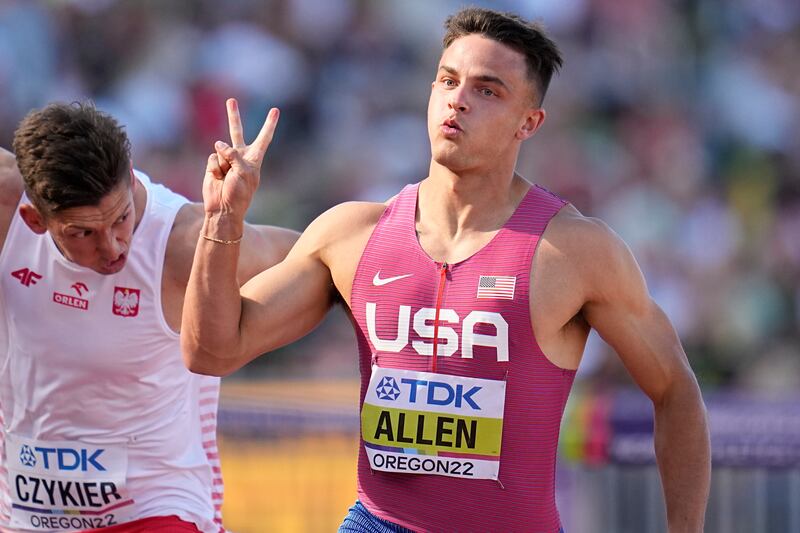Devon Allen, the NFL-bound world-class high hurdler, was disqualified from the final of the 110-meter high hurdles Sunday evening at the world track and field championships in Eugene, Oregon, — for being too quick.
The official ruling was that he was disqualified for a false start, but that isn’t what actually happened. In other words, he did not start running before the sound of the starting gun. He simply reacted faster than human beings are supposed to be able to react — faster than some scientists say an athlete can react, although even they seem dubious on this point.
World Athletics — the governing body for international track and field — has a rule that stipulates any reaction at the starting line that is faster than .100 of a second is considered a false start and therefore a disqualification. Allen’s reaction time was .099 — one one-thousandth of a second under the allowable limit.
Two female sprinters were DQ’d for the same reason in the semifinals of the 100-meter dash — Julien Alfred (reaction time: .095) and TyNia Gaither (.093).
No early movement by Allen could be detected on TV replays, even in slow motion; that’s because, as noted previously, there was no early movement. He simply reacted too quickly, as if there should be such a thing.
All of which is exactly what the sport did not need. Australian sports broadcaster Quentin Hull tweeted: “Undetectable to the naked eye. The kind of moment that alienates track fans.”
Track and field is desperately trying to find an audience, which is one reason it came up with the silly mixed relay event, but the sport is failing miserably. It is WNBA-bad when it comes to interest.
Nothing is reported on any of the major sports news websites — not even the USA championships, the world championships or the NCAA championships. It usually requires a gimmick to make news — for instance, when NFL wide receiver DK Metcalf ran in a track meet (even though he was routed), or, in this case, the DQ of Allen, a football-player-to-be that got a small mention on CBS Sports.
The trouble is, the sport keeps getting in the way of itself. Track is track’s worst enemy, and this ridiculous false start rule is a good place to start.
In the very same race in which Allen was DQ’d, Shane Brathwaite and Trey Cunningham had similarly fast reaction times of .108 and .109, respectively. Cunningham won the silver medal. Allen was a medal favorite himself. Earlier this season he produced the fastest time of the year and the third fastest ever, 12.84. He didn’t even get to run the race.
Brathwaite’s reaction time was only .009 of a second different than Allen’s, and Cunningham’s .010.
The blink of an eye is one-tenth of a second or 100 milliseconds.
Who can truly say that an athlete can’t react to a gun faster than .100?
After decades of failure, it was once believed that a sub four-minute mile was impossible, that such an effort might be beyond the capabilities of the cardiovascular system. The world record now is 3:43.13.
A two-hour marathon (an average pace of 4:34 per mile) was considered impossible until someone did it.
The world record in the long jump was 27 feet, 4 ½ inches when Bob Beamon leaped 29-2 ¼, a feat that was so ridiculous that it had never even been considered.
A dozen years ago, World Athletics (known as the IAAF at the time), commissioned Finnish researchers to study the minimum auditory reaction time — in other words, an examination of the neuromuscular reaction time to an auditory stimulus (a gun shot, for instance) to determine if the 100 millisecond limit was correct.
The research paper was called “the IAAF Sprint Start Research Project: Is the 100 millisecond limit still valid?” and was written by Paavo V. Komi, Masake Ishikawa and Jukka Salmi. The study — which examined seven sprinters who took part in the program — revealed reaction times as fast as .080, much faster than Allen’s. The study recommended that the 100 millisecond limit be lowered to 80 or 85 milliseconds. It also recommended that false starts be based on visible body movement before the start, using high-speed cameras.
(Personally, I believe the fewer the machines, the better; allow judges to determine it based on simple observation at the starting line.) The Finnish study arrived at largely the same conclusions as similar studies published by researchers in Britain and Canada in 2007 and 2008, respectively.
As we saw last weekend, World Athletics has continued to enforce the false-start rule at the .100 millisecond limit, and it cost Allen a chance to medal. Earlier this year he signed a contract to play football for the Philadelphia Eagles. He hasn’t played the game since 2016, when he starred at wide receiver for the University of Oregon. After incurring a couple of knee injuries, he gave up football to focus on track (he was the NCAA hurdles champion). He has won three U.S. championships and placed fifth and fourth in the last two Olympic Games, respectively.
Track and field has wrestled with the false-start rule for decades. For a time, each sprinter was given two false starts — the second one resulted in a DQ. This allowed athletes to try to anticipate the gun, so it had to go. Then there was a time when a false start by one sprinter was credited to the entire field and if someone else false started then he/she was DQ’d. That never seemed fair, either. Today’s rule: One false start and you’re out. That, in itself, is fine. But basing a false start on reaction time is problematic from, well, the start.
Let’s return to the simple eye test — does the judge see movement before the gun? — and use cameras as a backup, if necessary, at the championship events. Based on what we saw last weekend, something has to change.



